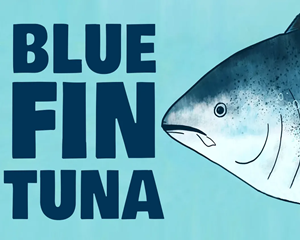What's as big as a polar bear, swallows its prey whole, and swims at 40 miles an hour?
什么动物像北极熊这么大,把猎物完整吞噬,又能以时速40英里游泳?
It's not a shark or a killer whale. It's the Atlantic bluefin tuna.
它不是鲨鱼或杀人鲸,它是大西洋蓝鳍金枪鱼。
The largest and longest-lived of the 15 tuna species, the Atlantic bluefin has a unique set of adaptations that make it one of the most dominant predators in the ocean.
大西洋蓝鳍金枪鱼是15种金枪鱼中最大、最长寿的品种,演化出了独特的能力,令它成为海洋里最强大的猎食者之一。
It starts as a tiny hatchling in the Gulf of Mexico or the Mediterranean Sea, no bigger than a human eyelash.
一开始它们在墨西哥湾或地中海孵化,比人类的睫毛还小。
Within its first year of life, it develops something known as regional endothermy -- the ability to regulate its body temperature.
在它满一岁前,它会发展出区域内温性--一种能调节身体温度的能力。
An Atlantic bluefin gets oxygen from cold ocean water using its gills. This process cools its blood.
大西洋蓝鳍金枪鱼通过鳃从冰冷的海水获得氧气,这个过程会令血液变冷。
Then, heat the tuna generates swimming and hunting warms the blood.
然后通过游泳和狩猎产生的热会令血液变暖。
In most fishes, this heat would be lost back out into the ocean through the gills.
就大部分鱼类来说,这些热量会通过鳃向海洋流失。
But in the Atlantic bluefin, a mechanism called countercurrent exchange traps the heat.
但大西洋蓝鳍金枪鱼则以一个叫做逆流交换的机制来锁住热量。
Cold blood on its way to the large swimming muscles passes close to warm blood leaving those muscles in a specialized network of blood vessels known as a rete mirabile.
冰冷血液往大型游泳肌肉流动,会近距离经过正要离开那些肌肉的温暖血液,这个血流交错的区域构成特有的血管网络,称为迷网。
Here the heat "jumps" to the cold blood and stays in the body. This makes bluefin one of the few warm-blooded fishes, a huge advantage in the marine environment.
热量会在这里转移到冷的血液中,并留在体内而不流失。这使蓝鳍金枪鱼成为少数的温血鱼类,在海洋环境中是个很大的优势。
Cold-blooded animals whose body temperature depends entirely on the environment become sluggish in colder waters.
冷血动物的身体温度完全取决于环境,使它们在冰冷的水里变得迟缓。
But a bluefin's ability to keep warm means it has sharper vision, can better process information, and can swim faster than its prey.
而蓝鳍金枪鱼让身体保持温暖的能力使它的视野更锐利、处理信息的能力更好、比猎物游得更快。
It thrives in cold, deep, subarctic water.
它在寒冷的亚北极水域深处茁壮成长。
Thanks to their warm bloodedness, their powerful muscles, and their streamlined torpedo shape with fins that fold into grooves to reduce drag,
它们仰赖温血的身体、强健的肌肉,以及能将鱼鳍收在体表沟槽内以减少阻力的鱼雷形流线身材,
bluefin tuna can reach speeds few other animals can match.
来达到少有其他动物能与之比拟的速度。

Their maximum speed of 40 miles per hour is faster than that of a great white shark or orca whale,
它们的最高时速能达40英里,比大白鲨和虎鲸的速度更快,
and even at their comfortable cruising speed, they can cross the Atlantic in a couple months.
就算以轻松的巡航速度,它们也可以在几个月内横跨大西洋。
All this swimming requires a great deal of oxygen, but the bluefin is adapted for this as well.
这样游泳需要大量氧气,但蓝鳍金枪鱼也演化出适应的能力。
The faster it swims, the more water passes over its gills, and the more oxygen it can absorb from that water.
它们游得越快,就有越多水流过鳃,也就能从水里吸取越多的氧气。
This need for a constant flow of water means the tuna must always remain on the move.
为了有不间断的水流,它们必须不停游动。
It also means bluefin cannot suck prey into their mouths the way most other fishes do.
这也意味着蓝鳍金枪鱼不能像大多数其他鱼类一样,将猎物吸入口中。
Instead, they must chase down their prey with their mouths open.
它们必须张大嘴巴从后面追上猎物。
They eat smaller prey than most predators their size, including squid, crustaceans, and smaller fish species like mackerel.
比起其他差不多身形的狩猎者,它们所吃的猎物更小,包括鱿鱼、甲壳类和较小型鱼类,像是鲭鱼。
The bluefin's temperature-regulating ability doesn't just make it a superior hunter -- it gives it nearly unlimited range.
蓝鳍金枪鱼调控体温的能力不仅让它成为顶尖的狩猎者,还令它无远弗届。
As soon as they're strong enough to swim against the current, Atlantic bluefin leave the warm waters of their spawning grounds and spend their lives hunting all over the Atlantic Ocean.
当它们成长到能够逆流前进时,大西洋蓝鳍金枪鱼会离开它们出生的温暖水域,在大西洋各处狩猎。
Tunas from both the Gulf of Mexico and the Mediterranean Sea frequent the same feeding grounds and range from Brazil and Texas to Iceland and Senegal and beyond.
从墨西哥湾和地中海来的金枪鱼会在相同的地点觅食--从巴西和得克萨斯州,到冰岛和塞内加尔,甚至更远。
But when the time comes to reproduce around age 10, they always return to their sea of origin.
但当它们到了10岁的繁殖期时,它们总会回到自己出生的海域。
Here, groups of males and females release millions of eggs and sperm into the water.
在这里,雄鱼和雌鱼会排出成千上万的卵子和精子到水里。
They'll migrate back and forth between feeding and spawning grounds annually for the rest of their lives.
它们每年都会在觅食地和繁殖地往返迁徙,直到生命的尽头。
Atlantic bluefin can live for over 40 years, growing all the while. The largest specimens are tens of millions of times heavier than when they hatched.
大西洋蓝鳍金枪鱼能活超过40年,并不断生长,体型最大者比刚出生时大上千万倍。
The same huge size that makes bluefin tuna indomitable in the ocean has made them vulnerable to one predator in particular: us.
这个让它们称霸海洋的庞大体积使它们在一种猎食者前显得特别脆弱,这个猎食者就是我们人类。
Humans have a long history of fishing Atlantic bluefin -- it's even stamped on ancient Greek coins.
人类捕猎大西洋蓝鳍金枪鱼的历史久远,连古希腊的硬币上也打有图样。
But in recent decades, demand has skyrocketed as bluefin are hunted for sashimi, sushi, and tuna steaks.
而在近几十年,蓝鳍金枪鱼的需求急增,它们被做成刺身、寿司和鱼排。
An individual fish can sell for $10,000 or more, promoting overfishing and illegal fishing.
单单一条鱼就能卖得一万美元以上,使过度捕鱼和非法捕鱼更为猖獗。
But if recent conservation efforts are redoubled and quotas are better enforced, bluefin populations can begin to recover.
但如果能够加倍保育力度和加强执行限额,蓝鳍金枪鱼的数量就可以开始恢复。


